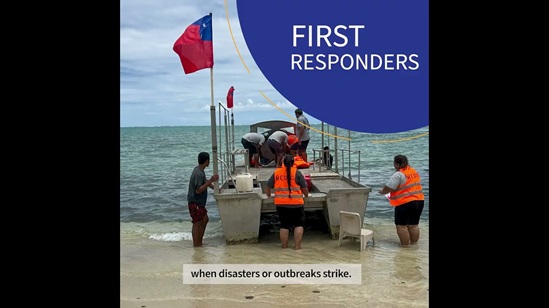Emerging disease surveillance and response in the Pacific
All Pacific island countries and areas are vulnerable to emerging infectious diseases, including pandemics, food and water insecurity, and to natural hazards, especially extreme weather events that are expected to increase in severity or frequency as a result of climate change. These hazards threaten national and regional health security and can cause lasting social, political and economic vulnerability.
WHO assists countries and areas in the Pacific to strengthen infectious disease surveillance and response systems. A key activity is the management and coordination of the weekly Pacific Syndromic Surveillance System (PSSS) that provides early warning alerts for potential disease outbreaks. PSSS collects, collates and reports surveillance data from 23 Pacific island countries. The system reports information that could indicate the start of an outbreak-prone disease.
Pacific syndromic surveillance reports
Latest Pacific Syndromic Surveillance System bulletins
Pacific syndromic surveillance reports archives
- Pacific Syndromic Surveillance System Weekly Bulletin 2024
- Pacific Syndromic Surveillance System Weekly Bulletin 2020
- Pacific Syndromic Surveillance System Weekly Bulletin 2019
- Pacific Syndromic Surveillance System Weekly Bulletin 2018
- Pacific Syndromic Surveillance System Weekly Bulletin 2017
- Pacific Syndromic Surveillance System Weekly Bulletin 2016
- Archives on PPHSN website
The Pacific Public Health Surveillance Network (PPHSN)
The Pacific Public Health Surveillance Network (PPHSN) is a voluntary network of countries, areas and organizations. Created jointly by WHO and the Secretariat of Pacific Communities in 1996, PPHSN is dedicated to the promotion of public health and improving public health surveillance and response to health emergencies in the Pacific. Its main priority is communicable diseases, especially ones prone to outbreak. Target diseases include: dengue, measles, rubella, influenza, leptospirosis, typhoid fever, cholera, SARS and HIV/STIs.
To achieve its goals, PPHSN harmonizes the health data needs of Pacific countries, develops adequate surveillance systems and computer applications, adapts public health surveillance training programmes to local and regional needs, and promotes opening the network to new partners, new services and other networks.








